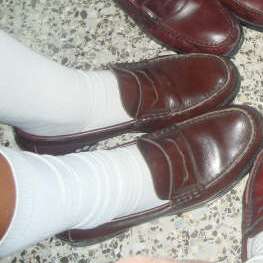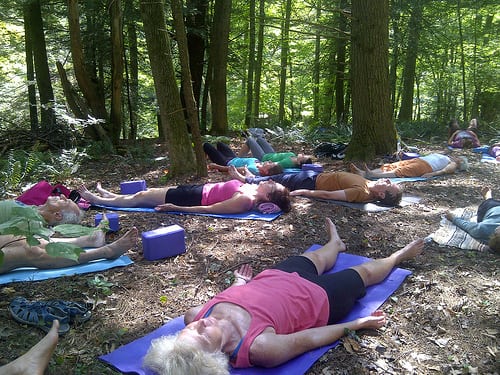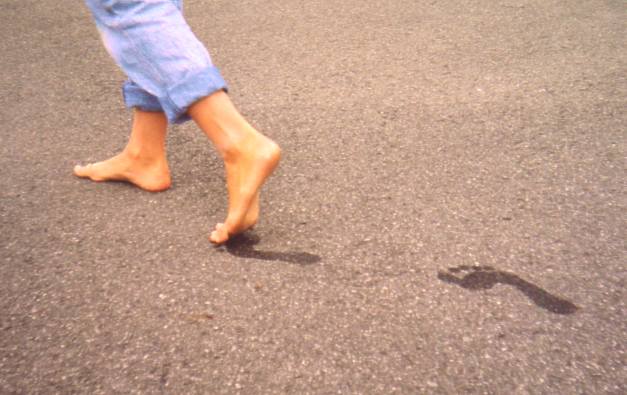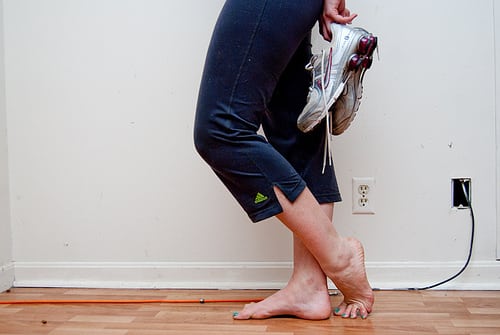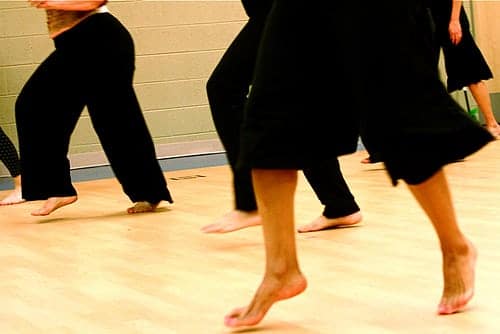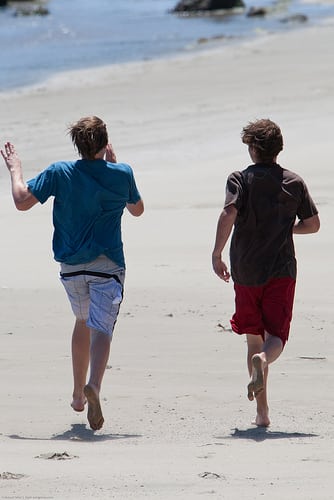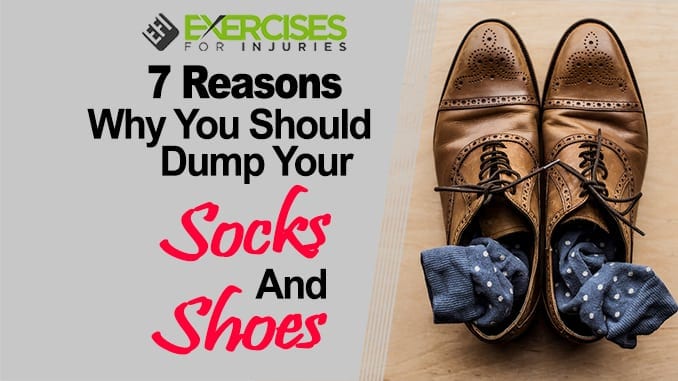
Socks and shoes certainly have a purpose as you already know and there can definitely be a place and a time for socks and shoes.
However, could there also be benefits associated with dumping your socks and shoes?
Yes, it may seem a bit ‘over the top’ in the modern age to be seen moving about without shoes or socks, especially when outside your home and not at a beautiful sandy beach!
Indeed, before shoes were invented, people were going about their business without much cushioning or protection on their feet. Typically, sandals or other forms of light footwear were used to hunt for food, raise cattle and do other things.
Hence, what reasons could there possibly be in this modern age for dumping your socks and your shoes?
Here are 7 reasons why you should!
#1 – Earthing
This is also referred to as grounding, and yes, it can be a good thing! There are negative electrical charges which move around and also pass through the earth. During historic times, mankind was walking in closer proximity to the ground, sitting on the ground and sleeping on the ground or close to the ground with pieces of cloth or flat mats of material.
Over time, people have embraced modernization with its many conveniences and as a result, the modernized world has lost some of its connectivity with the earth. Today, our feet, hands and bodies are typically quite far from the ground. We wear shoes, eat at a table and sleep in beds. These are all nice and convenient.
However, there are health benefits which could be derived from walking barefoot on the ground. When standing barefoot on the ground, the soles of your feet are able to absorb the negative earth charges which produce an effect related to anti-inflammation and your connection to the earth in this form could lead to a state of general wellness and a lack of dysfunction [1].
So, next time you are barefoot and connecting with the earth, embrace the natural flow of energy and well-being!
# 2 – Neutralization of Free Radicals
As your feet touch the earth, contact is made with the earth’s oscillations of negative charges and these could also be important to the body’s biological clock and regulation of the body’s cortisol secretions. Studies also show that these charges could have antioxidant properties that are able to neutralize free radicals in the body and affect the body’s immunity [2].
Grounding has also been linked to relief from problems related to tendons, carpal tunnel syndrome, and lower cardiovascular disease risks.
Hence, standing, walking, or running barefoot brings you in direct contact with negative electrical charges that are linked to the neutralization or reduction of reactive oxygen species directly related to different kinds of inflammation.
#3 – Alteration of Gait
Shoes could affect the way that a person’s feet touch the ground especially during walking or running. Such patterns of movement are also known as gait and research shows that the gait of people, especially children in their early childhood years can be affected by the shoes they wear [3].
Based on the cushioning support contained in modern running shoes, the heels of the leg can get elevated resulting in heels bearing the brunt of the force of impact with the ground. This could create an increased occurrence of injury.
On the contrary, going barefoot more likely provides a better landing for the feet. Inadequate commercial footwear has been linked to the prevalence of the condition known as flatfoot and results show that wearing flexible or slimmer shoes should be recommended during early childhood [4].
Communities around the world that continue to go barefoot or wear minimal footwear such as those populations found in developing countries show significantly reduced rates of injury. Although shoe manufacturers attempt to mimic the way the feet move, it can be difficult to achieve this with commercial shoes. Some customized shoes may more closely match feet outlines and movements. However, a variety of commercial shoes, especially shoes for runners and children are unable to mimic the natural gait positioning and patterns that bare feet exhibit.
#4 – Reduced Likelihood of Injury
Yes, this may seem counter-intuitive because shoes are meant to protect the feet and provide comfort. However, although wearing socks and shoes may protect the feet from some types of injury such as the feet being penetrated by sharp objects, going barefoot could actually reduce the risk of other types of injury like plantar fasciitis and sprains.
Due to the restrictions presented by socks and shoes, a fall or stumble could result in a sprain due to the difficulty in determining how much the feet could twist or move when forced to do so. Being barefoot creates much better awareness of the positioning of each foot and there is less likelihood of any sudden shifts or change in the positioning of the feet.
Research in the area of determining the risk of injury while running or walking barefoot is still ongoing. However, it is a fact that feet are able to be less restricted by socks and shoes and this could create a better opportunity for control during stumbles or slips.
#5 – Use of Forefoot Strikes
The use of the front of the foot to land on the ground could decrease the chance of impact-related injuries. There is supporting data that suggest that a forefoot strike pattern, which is more likely when running barefoot, reduces ground reaction forces [5].
Though somewhat speculative, those who walk or run barefoot could notice an improvement in feet strike patterns and subsequent reductions in the tendency to get injured. However, simulated running on bare feet has been noted as being able to produce the more favorable forefoot striking patterns in female recreational athletes [6].
The arguments do continue regarding whether forefoot and mid-foot strike are preferable over heel strikes. Nevertheless, there is increasing research in this area suggesting that forefoot strike patterns, which likely occur during barefoot running, are better for the feet and body.
What are the benefits of using a forefoot strike? You are less likely to get a bruised heel if the heels of the feet are less impacted by the descent of a strike on the ground.
The forefoot and mid-foot strikes could also be less tasking for the knees. Pain and injury may result from how the legs and lower extremities behave when movement occurs during walking and running. There can be a difference in injury risk based on which part of the foot lands first on the surface. The rate of acceleration change sweeping from the knees to the heels and feet or vice versa could determine the type of impact that is felt when walking or running.
#6 – Reduction of Patellofemoral Stress
Ground reaction forces can create stress in the legs and lower extremities. However, taking off your socks and shoes could present an opportunity to reduce such stresses.
Statistical paired tests and the use of standardized mean differences were used to study this reduction with the conclusion that running with shoes creates elevated patellofemoral joint stress and this stress is reduced when running without socks or shoes [7].
Other research results also point to the reduction of peak patellofemoral joint stress by 12% when running barefoot in comparison to shod running or running with shoes and this reduction is based on reduced patellofemoral joint reaction forces [8].
Sometimes, such patellofemoral joint stresses are more prone during motions associated with ascents or descents such as in climbing stairs or a steep hill. Being barefoot could relieve such stresses on the joints.
#7 – Be Natural, Healthy, and Feel Good!
You probably know that dumping your socks and shoes can be seen as being a natural way to exist but do you know that it could also be seen as a healthy activity? Being barefoot can be perceived in a variety of situations as depicting health, youth, innocence, inhibition, independence, simplicity, freedom, confidence, fun, expression, sensitivity, cleanness, considerate and there have also been claims of the influx of energy and feeling good while walking or running barefoot [9].
Yes, there can be some negative descriptions in other situations associated with being barefoot such as poverty, danger, disrespect, unsanitary conditions, and vulnerability. However, there can be safe ways and places to be barefoot. There is also a heightened acknowledgment and awareness of your surroundings associated with being barefoot. In addition, bare feet are able to “breathe” rather than sweat in shoes. In reality, stinky feet are only usually associated with feet that have been in some type of shoes, socks, or both.
It is important to remember that socks and shoes do have a purpose and could protect you from hurting your feet on hard objects including nails, broken glass, and other items that could cause injury. However, there are good reasons why you should dump your socks and shoes and reconnect to the earth with your feet. Choosing to walk barefoot on soft ground, dirt pathways, grass terrain, or on a sandy beach could present a safer option and also enable you to reap the benefits of such activities. It may also be wise to start this trend gradually and as the benefits of walking or running barefoot begin to emerge, you may find that it is something you want to do over and over again.
If you want to end your suffering from plantar fasciitis, then check out Plantar Fasciitis Relief in 7 days here:
References
[1] Earthing: Health Implications – Journal of Environmental and Public Health
[2] Can Electrons Act as Antioxidants? – PubMed
[3] Effect of Children’s Shoes on Gait – PubMed
[4] Foot Motion in Children Shoes – PubMed
[5] Evidence to Support Forefoot Strike Pattern? – PubMed
[6] 12 Weeks of Simulated Barefoot Running – PubMed
[7] Patellofemoral Joint Stress – PubMed
[8] British Journal of Sport Medicine – Patellofemoral Joint Stress
[9] The Case for Bare Feet
Rick Kaselj, M.S
.


